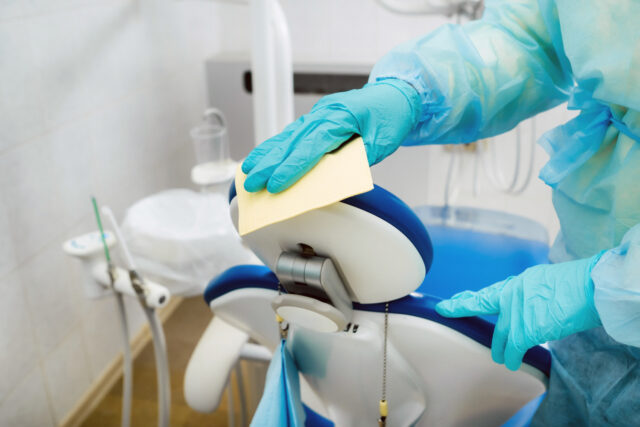Maintaining a spotless and disinfected dental office is not just about aesthetics; it’s essential for preventing the spread of infections. Here’s a recap of key decontamination practices to elevate the hygiene standards in your dental practice.
1. Surface Decontamination
Routine Disinfection: Regularly disinfect frequently touched surfaces like countertops, light switches, and equipment handles with an EPA-registered disinfectant. Do this after each patient and throughout the day.
Instrument Categorization and Disinfection:
- Critical: Surgical instruments require heat sterilization for maximum safety.
- Semicritical: Mouth mirrors and impression trays can be heat-sterilized, but chemical disinfection is an option for heat-sensitive items.
- Noncritical: Blood pressure cuffs and surfaces with minimal contact can be disinfected with an EPA-approved intermediate-level disinfectant.
Consider Decontamination Technology: Explore electrostatic sprayers or fogging systems for comprehensive disinfection. This can potentially reduce staff sick leave due to illness.
2. Water Quality Matters
- Regular Testing: Test your dental unit water for bacteria and pH levels regularly. Simple in-office testing kits or mail-in services are available.
- Maintain Waterlines: Follow manufacturer recommendations for proper waterline maintenance.
- Water Flushing: Flush water and air for 20-30 seconds after each patient from water-using devices.
3. Ensure Clean Air
- Invest in Air Filtration: Implement air filtration systems, especially in surgical rooms. Look for HEPA filters with UV-C light and activated carbon for optimal air purification.
- Fogging Systems as a Supplement: Consider decontamination fogging systems to target hard-to-reach areas and maintain a clean airspace.
4. Hand Hygiene and PPE
- Handwashing is Essential: Meticulous handwashing with soap and water or alcohol-based sanitizer is crucial before and after patient contact, and throughout the day.
- Follow OSHA Guidelines: Use appropriate PPE like gloves, masks, eyewear, and gowns depending on the procedure, as recommended by OSHA.
Beyond the Basics
- Patient Education: Inform patients about your decontamination protocols to build trust in your practice’s hygiene standards.
- Stay Updated: Regularly review and update your decontamination procedures based on the latest CDC and ADA recommendations.
By prioritizing these practices, you can create a safer environment for your staff, patients, and the wider community. Remember, a robust decontamination plan is not just about infection control; it demonstrates your unwavering commitment to patient safety and well-being.
SOURCE: CDC





